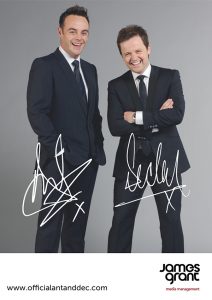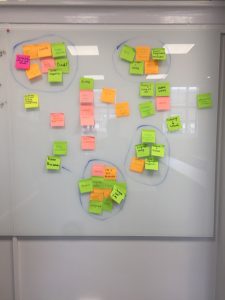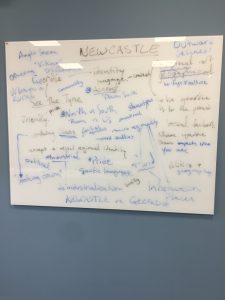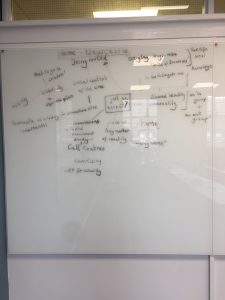The Tyne and Wear metro musical was a six month musical theatre, film and social history project looking to celebrate 30 years of the region’s iconic metro train service. Produced and written by Benjamin Till, the project was filmed over Tyneside and Wearside with local references abound…enjoy!
Author Archives: Rachel
Representations of Newcastle in Popular Culture

Here are the image hand-outs I distributed in class; the first, a collection of stereotypical references and iconography of Newcastle reinforced in popular culture.
Images taken from:
A Touch Far Vetched fan Blog – NUFC image
The Chronicle Live (local newspaper)
Amber Films website (local film studio)
The second, a collection of photos I took during research fieldwork in 2011, representing something of the reality of Newcastle (at that time)
What I was hoping to illustrate here, were how representations in popular media about Newcastle, construct and rely on stereotypes and caricatures (eg. the old steep cobbled streets of Byker, the landmark Tyne Bridge. There’s a familiarity about these images, which is part of the reason we except them and continue to refer to them as ‘standing for’ Newcastle.
The selection of photographs I took during fieldwork, observing, making notes and walking around Newcastle, shows some similarities to the first hand-out, so Cruddus Park housing block for example, communal living at least, not being dissimilar from the image of bygone Byker. However, the Polish café sign, and the ‘To let’ board in Chinese Mandarin, speak of a more culturally diverse Newcastle than the one being persistently portrayed in popular culture.
If you’re interested in this relationship between Popular Culture, Representation and the City take a look at the work of Grieves (1985). While some of the cultural references in this thesis are outdated, the theoretical framework of the piece is still very relevant.
Grieves, James (1985) Popular culture and public order: an empirical investigation into socio-cultural relationships in the city of Newcastle upon Tyne. Doctoral thesis, Durham University.
To finish then, take a look at the opening theme tune of popular BBC children’s drama from the 1980s, Geordie Racer (BBC Look and Read series, BBC Two, 1988, dir. David Meldrum). The city of Newcastle Upon Tyne was an integral feature of the show, a show which was incidentally praised as presenting a ‘grittier’ image of everyday family like to children’s television programming. What might this say about Newcastle’s (mis)place (ment) in popular culture? The iconic and rousing images of The Great North Run moving across the Tyne Bridge, against the traditional working class pastime of pigeon racing…
And finally, to link in with our thoughts on the song ‘Home Newcastle’ https://blogs.ncl.ac.uk/chnewcastleblog/2017/07/04/home-Newcastle , here are the lyrics to the theme tune of Geordie Racer, written by Derek Griffiths:
Flying free, flying high,
Flashing wings across the sky,
Geordie racer, Geordie racer.
On the road, in the street,
Hear the sound of pounding feet,
Geordie racer, Geordie racer.
Don’t wait, don’t stop,
You’re heading home.
Don’t rest, don’t drop,
You’re heading home.
In the air, on the ground,
See them moving all around.
Running hard, flying fast,
See them all go rushing past,
Geordie racer – fly!
Place and the fluidity of identity
You’ll need to zoom in on the photos to read our whiteboard ideas, but here’s a record of our classroom discussions yesterday.

These are some of the many really interesting points that came out of our discussions yesterday:
Regional identity
This idea that regional identity was loosing relevance, and in particular whether the ‘next generation’ (youth in the UK) are thinking more ‘nationally’ rather than regionally compared to previous generations (in the wake of Brexit? we mused). If you’re interested in this, have a look at Paasi’s work on regional identity:
Paasi, A, Region and place: regional identity in question, Progress in Human, 2016, Vol 27, Issue 4, pp. 475 – 485

Fluidity
Another point made was about the fluidity of identities, and this contestation between an ascribed identities and attributed identities. Take a look at Brah’s seminal work on Diaspora which argues that identity is fairly fixed culturally but malleable geographically:
Brah, E. 1996: Cartographies of diaspora: contesting identities. London: Routledge
Personal versus place
There was also some argument around whether our personality and familial ties and relationships governed our sense of place, rather than or physical geography. There was mention of ‘being born on the banks of the Tyne’ as a physical definition of being a Geordie, but then talk of accent as imperative to belonging and claiming identities. Something that we didn’t touch on, were experiences and memories of place, and in particular our sensory reception and then projection of place through these experiences. If you’re interested in this more psycho-geographic approach to identity, take a look at the work of Hough:
Hough, M, Out of Place: Restoring Identity to the Regional Landscape, Yale university Press, 1990: New Haven and London

Places that have a placed identity / ‘authentic places’
Another area of discussion was around some places having more of a placed identity than others, so Newcastle, for example, having many cultural and literary associations and stereotypes, having many physical outputs and industries, and being widely portrayed and ‘known’ in popular culture. All these aspects help to authenticate and brand the city, and with it, an identity that goes alongside the city. If you’re interested in this, there’s a very interesting article by Sim, who looks at the branding and authenticating of two towns in the Lake District via their food heritage and outputs.

(Souvenirs: branding and creating the city: photo taken during our live photostream exercise)
Sims, R, Food, place and authenticity: local food and the sustainable tourism experience, Journal of Sustainable Tourism, 17:3, 2009
There’s also some interesting work coming from urban planning and architecture on place making and place shaping, that looks at how to design spaces with placed identity in mind. Take a look at:
Performing Research
In 2014 I started to ‘write up’ my research on Polish migration to The North East. What I was left with, at the end of three years of long study, was a 99,000 word document that was fairly inaccessible to an audience outside the university, being both long and ‘academic’.
I then joined a ‘performing research’ group in Newcastle, where I aimed to turn sections of my thesis into a play about Polish migration in the North East.
Here’s a TED X talk all about the initiative ‘Performing Research’:
You can read more about some of the research projects turned into theatre work here: Performing Research Blog
If you would like to read sections of my play, please do ask and I will make hardcopies available.
Perhaps think about ‘performing’ your research project too; we’re open to poetry recitals, a theatrical interpretation, even dance.
Identity in Newcastle: Flickr Photostream
The identity in Newcastle Flickr Photostream

Here you’ll find a recording of 700 photos about identity in The North East of England that I took, uploaded, tagged, commented on, and categorised between 2010-2012.
The photostream shows how the categorisation of photos became an integral aspect of my project; selecting and ordering the photos so they made some kind of social scientific sense, placing them within a wider context. Creating a digital archive which aimed to capture some of the moments and signifiers of ‘identity’ in the North East during this time, now provides an interesting social history of that time. How many of these moments / sites are still there? If they’ve gone, what’s replaced them? (why do you think that is?)
The Culture Shock Project and Video
Culture Shock was a digital storytelling project that started in 2005, and recorded over 550 different stories from people across The North East of England.
Read more about the origins and legacy of the project here: About The Culture Shock Project
The project was a joint partnership between many different museum and heritage organisation in the North East, but it is extensively housed and maintained by The Tyne and Wear Museum Trust. What you’ll find if you look at this project is a fantastic, extensive digital archive of memories, voices, experiences, cultural moments, celebrations etc. from the region.
I took part in this project in 2010, and created this video about the arrival of my son, and as a way of thinking about my own arrival and place in Newcastle:
Cultural Shock: Geordie’s Arrival Day Video
You can create a similar digital story using this software:
Lightworks Free film editing Software
or even with PowerPoint on Word using the voice over facility.
‘Prezzi’ Presentation on Urban Art in The North East
‘Prezzi’ Presentation on Urban Art in The North East
Between 2010 -2012 I conducted an ethnographic study of ‘Identity in The North East’, photographing anything I deemed interesting as a comment on ‘identity’. Urban Art in the North East became an incidental but main feature of the project, as my interests grew, I started to see how urban art itself fell into different categories, and with that, held different cultural values and said different things. I’m interested in the link between urban art and place, so what art might say about an area and why.
Have a look at this Prezzi Presentation, as see what you think:
‘Prezzi’ Presentation on Urban Art
Do you agree with my classifications of urban art? What have I left out? Can you add to the collection?
Further Reading:
If you’re interested in conducting a project like this, here’s some further reading:
Metro-Roland, M, Tourists, Signs and the City: The Semiotics of culture in an urban landscape, Ashgate Publishing, London: 2012
Tourists, signs and the city : the semiotics of culture in an urban landscape
Biteable video: Identity in Newcastle
Here I have created a short video using the free software ‘Biteable’ to get you thinking about conducting your own ethnographic photography project of Newcastle.
Take a look at the video here:
In the video I mainly focus on ethnic and cultural identities such as ‘Geordie’, ‘Northern’, ‘Chinese Geordie’, but in your research you may want to think about identities in times of cross generation (such as ‘youth’), locality (such as ‘Northumberland Street’), religious identities (such as Buddhism) and /or subcultures (such as ‘goths’).
YouTube Film: The city in sound and image
The way we perceive ‘place’, in this case the city of Newcastle Upon Tyne, is influenced by the images and accompanying sounds used to define, stylise and objectify.
I have put together this short video using YouTube Editor, which aims to show how presenting the city through iconic images (in the case of Newcastle- the river, bridges, characteristic ‘Tyneside’ housing stock), and using a soundtrack more reminiscent of the way other big cityscapes are presented (so in this case I’ve chosen a jazz soundtrack, synonymous with the Manhattan skyline), removes Newcastle from the traditional ‘working class, football, heavy industry’ association or stereotype that we’re often talking about in class.
‘Imagining place’ or ‘constructing the city’, as is discussed in the literature surrounding this topic, is a way of inverting or supporting cultural expectations. In this video I have included some travelling shots, such as the view from an escalator going down in to the metro, to get a ‘big city feel’.
If you’re interested in this try these reading about place, branding, image construction, events, and the city:
Ed Aitken, S and Zonn, L (1994) Place, Power, Situation and Spectacle: A Geography of Film, Rowmann and Littelfield
Alberto Vanolo, The image of the creative city: Some reflections on urban branding in Turin, Cities, Volume 25, Issue 6, 2008, Pages 370-382, ISSN 0264-2751, http://dx.doi.org/10.1016/j.cities.2008.08.001
Abstract: Continue reading
